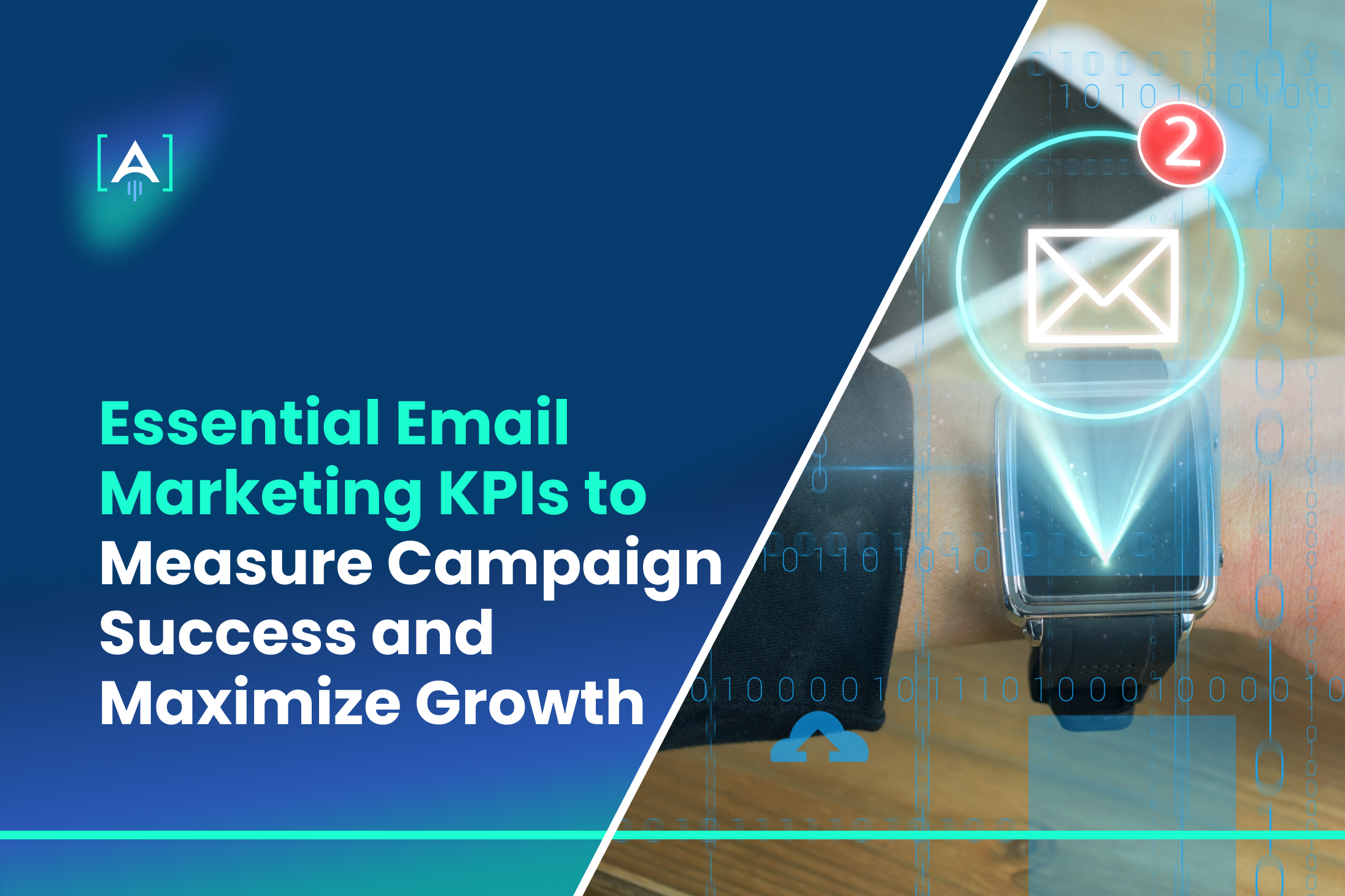Email marketing remains a cornerstone of digital strategy.
But how do you measure your campaign Success?
To truly gauge the effectiveness of email campaigns, it’s necessary to measure and analyze key performance indicators (KPIs).
These aren’t just numbers—they are the heartbeat of your campaigns, offering real-time insights into how your customers engage with your brand.
81% of companies use email as part of their marketing strategy.
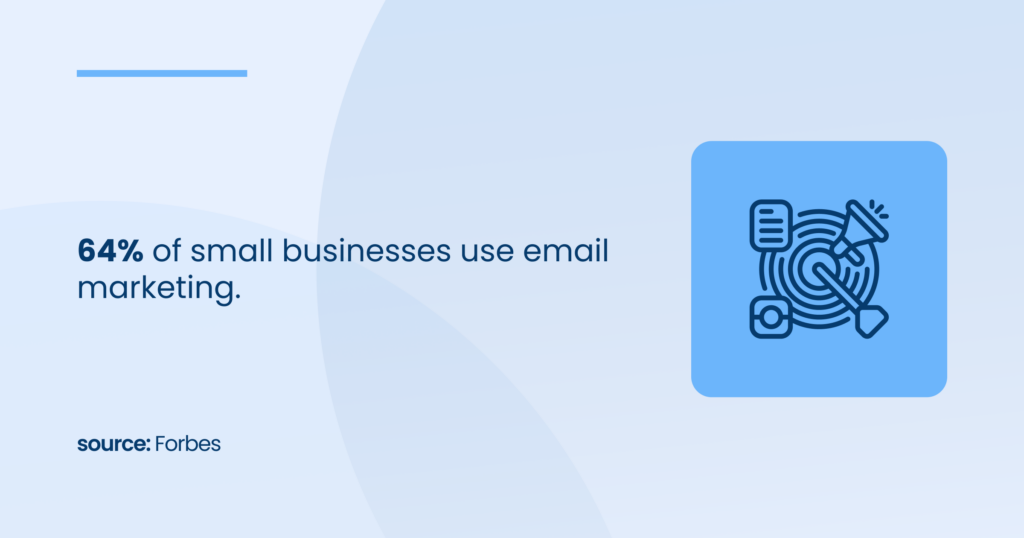
The essential values of Email Marketing metrics are:
- Maximizing ROI with Data-Driven Decisions
- Understanding Your Audience on a Deeper Level
- Enhancing Strategic Planning for Future Campaigns
For business owners and CEOs, understanding these metrics is the secret to turning every email into a strategic tool for growth. A reliable Email Marketing Agency can lead you through the process as effectively as it is possible.
In this guide to email marketing KPIs, you’ll learn about:
- Open Rates
- Click Through Rates
- Conversion Rates
- Unsubscribers Rate
- AI’s Influence on Email Marketing
Open Rates Are Just the Beginning: What They Tell You
When you first think of email marketing KPIs, one metric probably stands out: open rates.
But while this metric is valuable, relying solely on open rates is like trying to run a business with just half the data.
The Basics of Open Rates: What Are You Seeing?
The open rate tells you how many people opened your email, but there’s more to it than meets the eye. It’s influenced by a variety of factors, such as the effectiveness of your subject line, the time of day the email was sent, or even the email sender’s name.
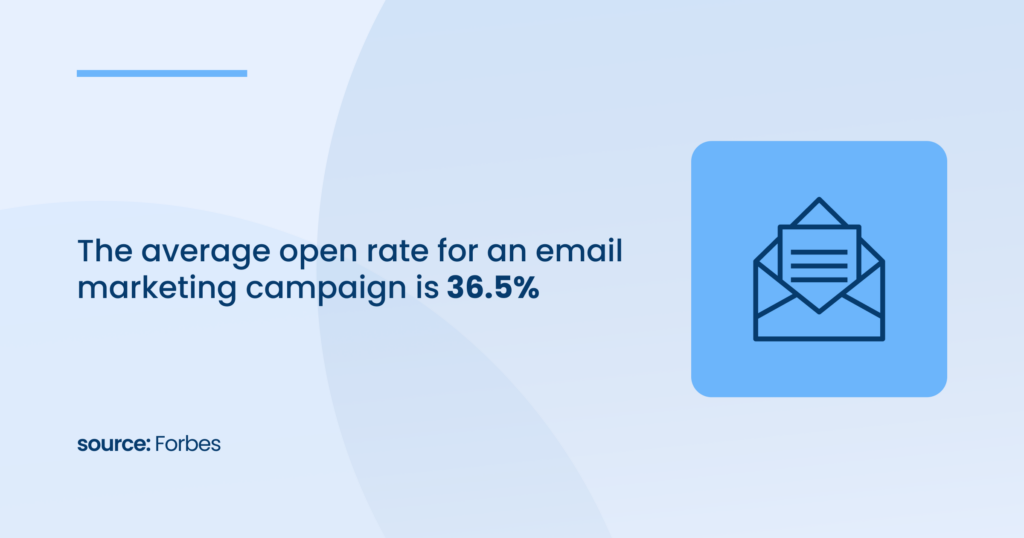
A higher open rate usually means your audience found something enticing at first glance—whether it’s curiosity or relevance. For CEOs, this means you’re doing something right in grabbing attention. But here’s the catch: attention is fleeting.
Open rates alone don’t tell the full story. You could have a great open rate, but if your audience isn’t clicking through or engaging with the content, you’re missing out on a major opportunity to move them through the email customer journey.
This is where the Click-to-Open Rate (CTOR) comes in. It measures the percentage of people who opened your email and then clicked on a link inside. In other words, it’s the action they took after opening.
If your open rate is high but your CTOR is low, that’s a red flag. Your subject line may be compelling, but something in the content isn’t resonating. Maybe your call-to-action (CTA) isn’t clear or engaging enough, or perhaps your message doesn’t match the promise of the subject line.
Why Context Matters: Open Rates in Isolation Are Misleading
Imagine you’re launching a new product, and you send out an email to your list of 10,000 subscribers. You get a 40% open rate, which sounds fantastic at first glance.
But if your CTOR is only 5%, it means most of those 4,000 people who opened your email didn’t find anything worth clicking on.
This is why open rates should never be analyzed in isolation.
You need to look at them in the broader context of other email marketing KPIs like CTOR, conversion rate, and even email deliverability.
Sure, someone may have opened your email, but did it inspire action? Did it lead them closer to making a purchase or further down the email customer journey?
To get the full picture, here are a few questions business owners and CEOs should consider:
- Did the open rate result in meaningful engagement? Analyze CTOR alongside open rates to see if those opens translated into clicks.
- Are your emails reaching the right inboxes? High open rates don’t always mean successful campaigns. A low deliverability rate may be limiting your audience. Focus on optimizing email deliverability to ensure more of your emails land in the primary inbox, not the spam folder.
- Does your content match your subject line? If people open your emails but don’t engage, there might be a mismatch between what your subject line promises and what the email actually delivers.
Clicks and Conversions: Where the Money’s Made in Email Marketing
When it comes to email marketing KPIs that directly impact your business’s bottom line, nothing is more critical than Click-Through Rates (CTR) and Conversion Rates.
If you’re a CEO looking to measure the return on investment (ROI) from your email campaigns, these two metrics are your most reliable indicators of success.
But what do they really mean, and why should you care?
The Power of the Click: Why CTR Matters for Revenue Generation
Think of the Click-Through Rate (CTR) as the point where curiosity turns into action. CTR measures the percentage of recipients who click on a link within your email after opening it. It’s a signal that your content grabbed their attention enough to make them take that next step.
For ecommerce email marketing, this often means clicking on a product, offer, or service that leads them to your website.
For business owners, CTR is where the magic starts. It tells you not just how many people opened your email but how many were engaged enough to take action.
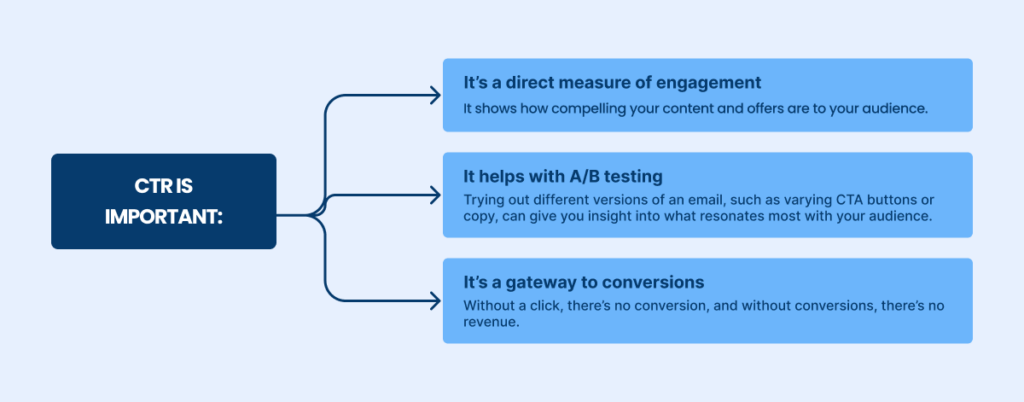
This engagement is essential for moving your audience further along the email customer journey, whether that’s adding items to a cart, signing up for a service, or even downloading a whitepaper.
The more people click, the higher your chances of converting that traffic into revenue.
CTR is also a valuable tool for email analytics. If you notice certain links or calls to action (CTAs) aren’t performing well, you can tweak the design, placement, or even the wording to improve your results.
According to a source, personalized email campaigns have a 29% higher CTR than non-personalized ones.
So, if you’re not already leveraging AI email marketing to tailor your emails to individual preferences, you could leave money on the table.
The Endgame: Understanding Conversion Rates and ROI
Now that we’ve covered CTR let’s talk about the real star of the show: Conversion Rates. While CTR tells you how many people clicked, Conversion Rate measures the percentage of those clicks that resulted in a desired action.
This could be a purchase, a sign-up, or whatever the goal of your campaign may be.
Source: Smart Insights
For CEOs, Conversion Rates are the key to understanding the effectiveness of your email marketing KPIs. After all, clicks are great, but if they aren’t leading to conversions, your emails aren’t delivering the value they should be.
Let’s break it down with an example.
Imagine you run an ecommerce business, and you’ve just launched a personalized email campaign offering a 10% discount on your newest product. Your email is sent to 10,000 subscribers:
- If 2,000 people click on the link (20% CTR), that’s an excellent engagement rate.
- But if only 100 of those people make a purchase (1% Conversion Rate), you now have a much clearer picture of how well your campaign performed.
This is why Conversion Rates matter so much. They tell you how effective your entire campaign was in turning interest into revenue.
Why CEOs Need to Pay Attention to CTR and Conversion Rates
As a CEO, your primary concern is ROI. You want to know that every dollar spent on creating email campaigns is coming back multiplied in revenue. This is where tracking CTR and Conversion Rates becomes vital. These metrics help you answer important questions, like:
- Are we reaching the right audience? If your CTR is low, your emails might not be resonating with the people on your list. You might need to segment your audience better or adjust your content.
- Is our offer compelling? A high CTR but a low conversion rate might indicate that your offer isn’t strong enough to convince people to complete the desired action.
- How much is this campaign worth? With solid email analytics, you can see exactly how much revenue is being driven by specific campaigns, helping you refine your strategy moving forward.
Statistically speaking, the average email conversion rate sits at around 2-5%, but this can vary widely depending on the industry and the quality of your campaigns. By combining a solid CTR with a high conversion rate, you can drastically improve the efforts of your email marketing ROI.
Using AI to Boost Clicks and Conversions
Let’s take things up a notch by bringing AI email marketing into the picture. AI can help optimize both your CTR and Conversion Rates by personalizing the customer journey for each recipient. For example, AI algorithms can:
- Optimize subject lines and content. AI analyzes historical data to create more engaging subject lines and email content, increasing the chances of a click.
- Personalize product recommendations. If you’re an ecommerce business, AI can tailor product suggestions based on previous customer behavior, making the offer more relevant and boosting conversions.
- Timing is everything. AI can help determine the best time to send your emails, ensuring they hit the inbox when your audience is most likely to engage.
Is Your Email List Healthy? Why CEOs Need to Care About Unsubscribes
Unsubscribe rates may seem like a small detail, but for business owners and CEOs, these figures are more important than they appear.
Think of your unsubscribe rate as a pulse check on how your audience perceives your brand’s email marketing strategies. When people unsubscribe in large numbers, it’s a red flag.
A high unsubscribe rate doesn’t just affect the size of your email list—it can damage your brand reputation and hurt your email deliverability. But let’s break it down in simpler terms to show why this matters.
The Damage of High Unsubscribe Rates: Why You Should Care
When your audience starts unsubscribing in large numbers, email service providers (like Gmail or Outlook) take notice. They use this as a signal that your emails may not be relevant or welcome.
And when that happens, your future emails could land in the dreaded spam folder instead of the inbox. This is where the concept of email deliverability comes into play.
Imagine you’re sending out cold email marketing campaigns or trying to engage customers with b2b email marketing. If your emails don’t even make it to the inbox, you’ve already lost the battle.
In fact, studies show that about 20% of marketing emails fail to land in inboxes due to poor deliverability. And a high unsubscribe rate can push that percentage even higher.
But the damage doesn’t stop there.
A high unsubscribe rate can also tarnish your brand image. If too many people are opting out, it may signal that your content isn’t relevant, engaging, or personalized enough. This can erode trust and cause your audience to disengage from your brand altogether.
Over time, this not only impacts the success of your email marketing campaigns but also your overall brand reputation.
So, what can you do to keep those unsubscribe rates low and your brand reputation intact? The answer lies in segmentation and personalization.
How Segmentation and Personalization Reduce Unsubscribes and Drive Long-Term Value
Personalized emails aren’t just a trend—they’re the foundation of effective email marketing.
Source: McKinsey&Company
When you send generic emails to a large group of people, you’re essentially throwing spaghetti at the wall, hoping something sticks. The result? More people will feel that your message isn’t for them and will hit that unsubscribe button faster than you can say “ROI.”
Segmentation allows you to divide your email list into more targeted groups based on behavior, preferences, demographics, or past purchases.
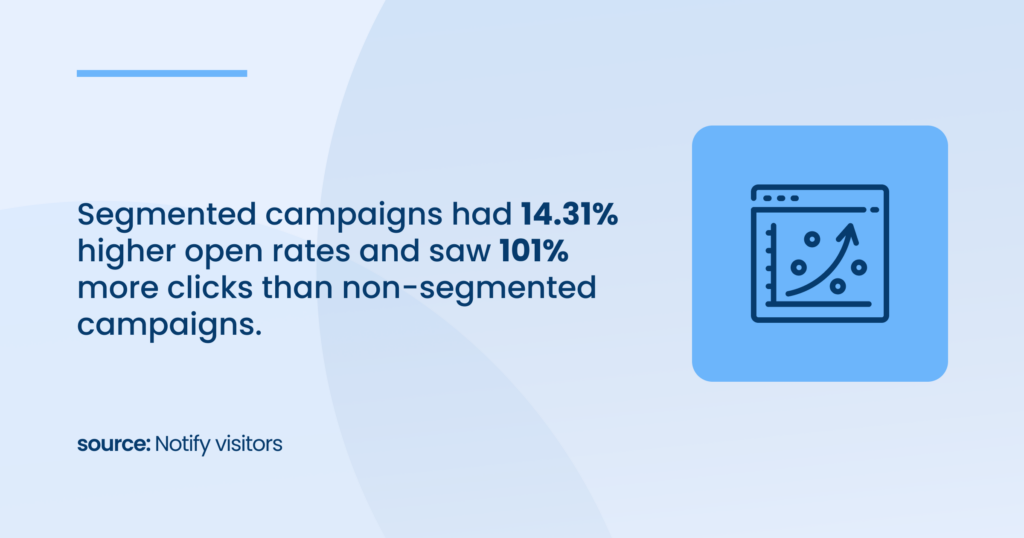
With AI email marketing, you can take this a step further by predicting what content will resonate with different segments of your audience, leading to higher engagement and fewer unsubscribes.
How to Reduce Unsubscribes with Segmentation and Personalization
Reducing unsubscribes doesn’t have to be complicated. By leveraging segmentation and personalization, you can turn things around quickly. Here are some actionable tips to implement:
- Use AI for hyper-targeting: With AI email marketing, you can analyze customer behavior and automatically segment your list based on preferences, engagement levels, and purchase history.
AI tools can even predict when a customer might unsubscribe and allow you to send them highly targeted content before they opt out.
- Segment based on engagement levels: Not all subscribers are at the same stage in their email customer journey. Some are ready to buy, while others need more nurturing.
Segment your list accordingly and craft emails that match where each customer is in the buying process.
- Personalize at scale: Even if you’re sending to thousands of recipients, personalization is possible. Include personalized subject lines, address recipients by name, or recommend products they’ve shown interest in before.
Personalization can make the recipient feel like the email was crafted just for them, making them less likely to unsubscribe.
- Give control to the customer: Sometimes, unsubscribes happen because you’re sending too many emails.
Allow customers to manage their preferences by choosing how often they want to hear from you. This can reduce unsubscribes and give your audience a sense of control.
Beyond Metrics: How AI Can Transform Your Email Marketing Strategy
Imagine if you could predict how your customers will behave tomorrow, next week, or even next month.
What if you could forecast exactly which subject lines will get them to open your email or what type of offer will drive them to click “buy now”?
This is where AI tools and predictive analytics step in, transforming traditional email marketing into a highly optimized, real-time strategy.
For business owners and CEOs, adopting AI isn’t just about following trends—it’s about unlocking new ways to boost engagement, improve personalization, and enhance your email marketing efforts.
How AI Can Predict Subscriber Behavior in Real Time
At its core, AI works by analyzing massive amounts of data, spotting patterns, and making predictions based on that information.
Source: Exploding Topics
When it comes to email marketing, AI tools can examine your subscribers’ past interactions, including:
- How often they open emails
- Which links they tend to click
- What products they’ve browsed or bought in the past
- The times and days they usually engage
This real-time data analysis helps AI tools forecast what your customers are likely to do next.
For example, if a subscriber tends to open emails with product recommendations on a Saturday morning but ignores newsletters sent during the week, AI will catch that pattern and optimize future campaigns accordingly.
Now, rather than sending blanket emails at random times, you can target your audience based on predictive analytics that accurately forecast their behavior. This leads to:
- Higher open rates: With the right timing and personalized subject lines, your emails have a greater chance of being seen and opened.
- Better click-through rates: Tailoring content based on what subscribers have previously clicked ensures that your next email is relevant and engaging.
- Increased conversions: Forecasting which products or services appeal most to each customer can drive them to make a purchase more quickly.
By using AI-powered predictions, CEOs and business owners gain a clearer picture of how subscribers interact with their emails, allowing them to pivot and adapt in real-time. The result? A more efficient, higher-ROI email marketing strategy.
The Power of Targeting: Reaching the Right People Every Time
As a business owner, your email list is one of your most valuable assets. However, not all subscribers are the same, and sending the same message to every customer can backfire.
Poor targeting can lead to high unsubscribe rates or, worse, damage your brand’s reputation.
Here’s where AI comes in: it enables precise targeting by evaluating customer behavior and engagement metrics.
Here’s how AI can improve your targeting efforts:
Engagement Scoring: AI tracks how often a customer engages with your emails and assigns an engagement score based on that activity. If someone consistently opens your emails and clicks through to your site, they might be ready for a special offer.
Conversely, subscribers who haven’t engaged in months may need a re-engagement campaign. AI can predict these trends, helping you target each group appropriately.
Predictive Models for Lapsed Customers: Not all customers remain active. However, with AI, you can use predictive analytics to identify when a customer is at risk of disengaging.
AI tools can automatically send targeted emails with personalized content or special offers to re-engage them before they lose interest entirely.
Geolocation Targeting: If your business operates across multiple regions, AI can help you optimize emails based on a recipient’s location. Let’s say you have a restaurant chain—AI can send weather-based emails with location-specific promotions, like offering warm beverages during a cold snap in a particular area.
Effective targeting ensures you’re not wasting resources on the wrong audience. Instead, every email you send becomes a well-aimed, relevant message designed to drive engagement and sales.
AI and Engagement: Keeping Your Audience Hooked
AI email marketing goes beyond just predicting behavior and improving targeting. It also excels at enhancing engagement.
By continuously analyzing how subscribers interact with your emails, AI learns what resonates most with your audience and makes real-time adjustments to boost engagement.
Optimized Send Times: AI tools can determine the best time to send emails based on when your audience is most likely to engage.
If your customer base tends to open emails during lunch hours or late evenings, AI will adjust your email schedule for maximum engagement.
Subject Line Optimization: AI tools can test different subject lines to see which ones generate the highest open rates. By continuously learning from each campaign, AI can help you craft attention-grabbing subject lines that get noticed.
A/B Testing at Scale: Testing different versions of an email is crucial, but it can be time-consuming.
AI simplifies this by running A/B tests at scale and automatically applying the winning version to future emails. The result? Better content, faster, and more data-driven decisions.
The End: Keep Your Eye on the Metrics That Matter
Now, you already know the importance of tracking the right KPIs.
Remember, these metrics don’t work in isolation. When combined with smart strategy and data-driven insights, they can guide you toward more effective campaigns.
[A] Growth Agency will be your strategic partner. Our experienced team will design a Growth Roadmap encompassing the vision, strategy, and tactics your business needs to grow. We specialize in turning entrepreneurial dreams into reality with effective, tailored growth strategies.
Moreover, we believe in the power of data to inform and drive every strategy, ensuring our actions are as effective as they are innovative.
Your next step is to take action.
We are here to support you every step of the way.
Ready to see your business grow?
